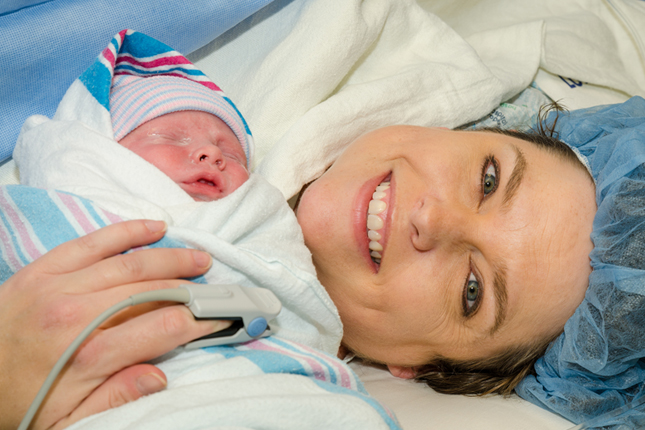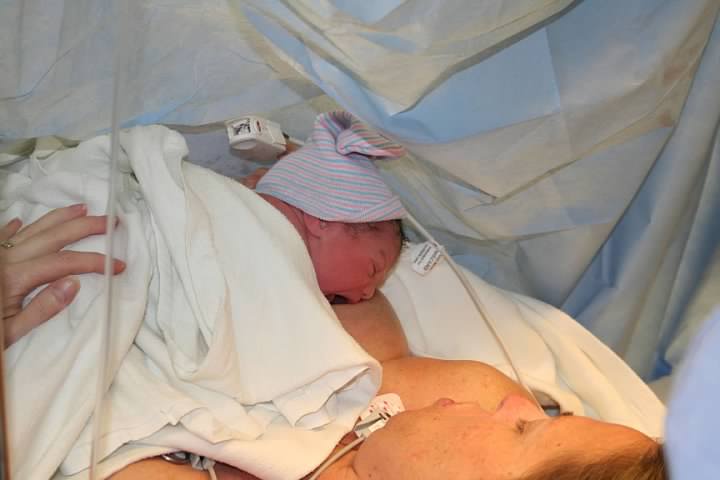The Boob Group
Breastfeeding After Cesarean
[00:00:00]
Please be advised, this transcription was performed from a company independent of New Mommy Media, LLC. As such, translation was required which may alter the accuracy of the transcription.
SUNNY GAULT: This episode of The Boob Group is brought to you by Rumina Nursingwear. Hands-free pumping and nursing tanks and bras to support your breastfeeding goals. Visit www.pumpandnurse.com and save 20% with promo code BOOBGROUP20.
[Theme Music]
ROCHELLE MCLEAN: Are you a mom who’s expecting to have a cesarean or belly birth? Are you concerned about breastfeeding after having the surgery and what kind of obstacles you might experience or perhaps you’re planning a vaginal birth and something changes that plan? I’m Rochelle Mclean, an IBCLC and owner of Babies in Bloom in Vista, California. Today, we’re talking about: “Breastfeeding After a Cesarean Birth.” This is The Boob Group.
[Intro/Theme Music]
LEILANI WILDE: Welcome to The Boob Group, broadcasting from the Birth Education Center of San Diego. The Boob Group is your weekly, online, on the go support group for all things related to breastfeeding. I'm your host, Leilani Wilde; I'm also an IBCLC and owner of Leilani’s Lactation and Doula Services.
Did you know we’ve released more than a 125 episodes to help you on your breastfeeding journey? Visit the episode guide on your website at www.NewMommyMedia.com to see a complete list. You can click on the episodes and listen through the website or download our free apps available in iTunes, Google Play, Windows and listen on the go.
You can also download our free New Mommy Media Network App and listen to all of our podcasts. If you enjoy listening then please take the time and tell other breastfeeding mamas about it so we can help encourage them as well. Now Sunny is going to tell us more about: “How you get involve and become a part of The Boob Group.”
SUNNY GAULT: Okay. Hi everybody. So there are a few different ways that you can get involve with our show. First of all, we have a Facebook Page and a Twitter Account. So if you are on either of those platforms, feel free to check us out. We’re always posting some interesting articles and sharing tips that we’ve learned. We’re also on Instagram. We have a New Mommy Media Account and I’m always taking pictures of the tapings and what we’re doing here behind-the-scenes that I always post photos to our Instagram account. So if that something that interest you, you can check that out.
We have a bunch of segments here on The Boob Group that we love to have your participation with. We have an: “Ask the Expert” segment where you can submit your own questions, any questions you have for our experts, breastfeeding – whatever topic you have. Simply go to our website and you can see a list of all of our experts there. Go to the contact’s link and you can submit your question from there. We’ll read it on the show and we’ll also get your question answered.
There’s another segment I really like called: “Boob Oops.” It’s where you share your funny breastfeeding and pumping stories. Same thing, go to our website; you can send us an e-mail. But you can also call us on our voice mail and that is 619-866-4775. Those are actually some of my favorite responses because we can actually hear your voice and you could tell your story yourself and we’ll put that on the show as well.
LEILANI WILDE: Today on our studio, we have Kristen. Would you like to introduce yourself?
KRISTEN STRATTON: Yes. My name is Kristen Stratton. I am a Birth Doula and a Postpartum Doula. I am the mother of three kids; ages five and a half, three and a half and two.
LEILANI WILDE: Good and thank you. Dawn, we have you on the phone.
DAWN ALVA: Hello. I’m Dawn Alva. I’m 42. I’m the founder of Rumina Nursing Wear. I have two little children – a boy age seven and a girl age two.
LEILANI WILDE: Wonderful. Then we have our expert Rochelle.
ROCHELLE MCLEAN: I am Rochelle Mclean. I’m a Board Certified Lactation Consultant, Doula and also Child Birth Educator. I have two kids – 21 and 19.
LELIANI WILDE: Wonderful.
SUNNY GAULT: All right, so before we kick of today’s show about: “Breastfeeding After cesarean,” I saw this article online and I thought it was kind of funny. It’s rubbing some people – no pun intended; rubbing some people the wrong way. There was a mama who got a spray tan and she didn’t weight the necessary amount of time. I don’t know if you guys have had spray tans. I’ve done this a couple of times in the past. If you do not weight like how many hours before putting on clothes, basically just kind of comes off of your body and it rubs off.
Apparently, she didn’t weight the recommended amount of time before breastfeeding her baby and her baby kind of ended up with a 5:00 shadow on its face. As a mama, sometimes we find these things funny and we may share this with friends. She posted something in the Facebook. She posted a photo of it and she was really kind of funny about the whole thing.
She wrote: “From one mom to another – this is in the UK.” I’d like to let you know about my epic fail of fails. Yesterday, I had a spray tan. A few hours later, I breastfed my little boy and then queue 5:00 shadow and a very guilty mommy – she says. Then she included the photo of her so. So it’s getting some mixed reviews. Some moms are like: “She’s the funniest thing ever.” Other people are like: “You’re a horrible mother. Why are you getting a spray tan? You’re going to get cancer. Then you’re not going to be there for your son.” It’s just like all over the maps. So I thought I would talk about it just to see what you guys thought about it especially as lactation consultants.
Obviously, we have to watch what we consume, what we put on our bodies if our babies are actually latching and breastfeeding. It doesn’t say if she actually had the spray. Actually, she would have all over her breast then. So I mean is that something that we should be concerned about? Is this just kind of a funny story that’s like: “There are bigger fish to fry kind of thing – why are people worried about this?” Rochelle?
ROCHELLE MCLEAN: I am kind of the thought process. It’s hard enough being a mom. She’s doing the best that she can do and I just don’t see the outcry. I don’t know. I think a lot of people do a lot more harmful things than that. I think she was admitting it. She was just kind of being playful, it happens. I like that she was willing to put herself out there and say: “Look. I made a mistake. We all make mistakes.”
SUNNY GAULT: Yes.
ROCHELLE MCLEAN: I wish people are a little bit more expecting and not as judgmental.
SUNNY GAULT: This would have been a good Boob Oops.
ROCHELLE MCLEAN: Yes.
SUNNY GAULT: She should everybody like contacted us and told us about her story, right?
LEILANI WILDE: Yes, that would have been pretty good.
SUNNY GAULT: I know right. What do you think Leilani?
LEILANI WILDE: Well do you know what? I agree with Rochelle. It is hard being a mom and we do make choices all the time every single day, sometimes we make choices, sometimes we don’t. As far as whether or not it’s safe to breastfeed after spray tanning, I suppose getting educated in advance – that would be helpful. Then she can fight fire with fire.
SUNNY GAULT: Kristen, any thoughts?
KRISTEN STRATTON: From one mommy to another, I definitely done things that I’m like: “I probably shouldn’t have done that.” But that’s the whole part of being a mom. If we all knew everything we need to know in advance, I don’t know if any of us would do it to be honest. But do you know what? I’m actually kind of applauding her for putting herself out there and being an example to other moms. Hey, stuff happens. Sometimes you just got to laugh.
SUNNY GAULT: Yes.
KRISTEN STRATTON: Also, I applaud her for doing some self-care because I definitely could use a little bit of that and so I don’t know. I think she did the right thing and anyone else is taking it too seriously. Just probably needs to have a good laugh and they’ll feel better.
SUNNY GAULT: Yes. Dawn, what do you think?
DAWN ALVA: I think social media is really interesting right? As a mom, even just something as light-hearted as I would assume that her post was. This is like: “This was cute. It was funny. Oops, I won’t do that again.” People go into a lot of the judgment and it makes moms I think closed down and not be as supportive. So I think what she did was probably what all of us have done in another stand points not exact situation.
But I wish we all would just be more forgiving and loving to each other. Yes, I need a spray tan on my legs and it’s been two and a half years since my daughter has been born. Maybe that’s where we all go next.
SUNNY GAULT: All right ladies, thanks for sharing your opinions.
[Theme Music]
LEILANI WILDE: Today on The Boob Group, we’re discussing: “Breastfeeding after having a cesarean birth.” Rochelle Mclean, an IBCLC in Vista, California is an expert on this topic. She’s joining us here in the studio. Welcome to the Boob Group Rochelle.
ROCHELLE MCLEAN: Thank you for having me.
LEILANI WILDE: Rochelle, how soon after a cesarean birth can a woman breastfeed?
ROCHELLE MCLEAN: As soon as she is alert and ready to go. So often times, it will take place in the recovery room in the hospital. Most hospitals will bring the baby in to meet mom there. But as soon as she’s alert and awake, the sooner the better.
LEILANI WILDE: Will she need help?
ROCHELLE MCLEAN: She will definitely need help. The one thing about Cesareans that are good if you would is: “Usually if the mom is reclined and that’s a great first position for babies for latching.” So moms are often times reclined in bed so baby gets place just right on top of her which is a great position and kind of terms on all the natural reflexes for babies and helps them to latch.
Immediately after surgery, most moms have pretty good pain control; so that part is a little bit helpful for them to not to be worrying about incisional pain. They will often times still have monitors on their arm, IVs and things like that. So definitely having support of nurses, partners and family members who can help get her to get the baby where she needs the baby and to feel supported – lots of pillows, lots-and-lots of pillows in the beginning in the first feed.
LEILANI WILDE: Okay good. Dawn, how soon after you gave birth did you breastfeed?
DAWN ALVA: Probably, I would say at one minute. I was one of the fortunate ones. I advocated pretty heavily at my baby friendly hospital to actually do skin-to-skin and breastfeeding in the OR. So I was able to have her crawl on me and find and latch just like I saw on the videos of a standard, natural birth. So I was one of the fortunate ones.
LEILANI WILDE: That’s great. What about you Kristen?
KRISTEN STRATTON: That’s amazing. I actually have my kids before that I was kind of the place where we’re going with Cesarean Births. So I just breastfed my kids in the recovery room. But it wasn’t overall pretty good experience like Rochelle said. Usually your pain control is under a comfortable level. Then, I also was pretty tired because I had some unplanned cesarean with labor. After that, she said: “Lots of pillows and lots of support from nurses to help you get a good latch.”
LEILANI WILDE: How soon after were you able to latch?
KRISTEN STRATTON: Probably within an hour.
LEILANI WILDE: Okay good.
KRISTEN STRATTON: Yes.
LEILANI WILDE: Good.
DAWN ALVA: I should caveat mine. I apologize. This is Dawn. So my second birth with Cesarean, I advocate for and that was the experience. The first experience I had was an emergency C Section which was very similar to yours Kristen. I actually went to the recovery room and that was the more traditional approach to breastfeeding within that experience. So I’ve had two and both of them are exceptionally different.
LEILANI WILDE: Did you find that you had a lot of support in both cases?
DAWN ALVA: Yes from all the staff, absolutely. I love the nursing staff; they’re amazing at our hospital. What I think was a little different is: “My son and I, our relationship was different than my relationship with my daughter having been able to connect with her in a different way.” So I do attribute that in the OR but I don’t think that’s standard across the board. I just struggled the first time. So I advocated hard for the second time to do things a little differently and it just happened to work out for me.
LEILANI WILDE: Wonderful. Rochelle, can you tell us what the benefits of breastfeeding as soon as they can?
ROCHELLE MCLEAN: Sure; so the sooner, the better both for mom and baby. For mom, you get the release of the Oxytocin which can help with the contraction of the uterus to get it to start involute to go back down and to minimize bleeding. It’s a very big bonding time with all of the Oxytocin in her system.
Then for baby, being skin-to-skin and being latched on helps with:
• Blood sugar
• Respiration rate
• Body temperature
• Heart rate
All of those things that are good in stabilizing; so the sooner, the better and definitely within the first hour if possible – I have to say, I love hearing stories that we are seeing moms now to getting to do it in the OR. My first, it was born via C-Section. So 21 years ago, we didn’t see babies for six hours and it was uncomplicated. He was healthy.
Just when you have a cesarean baby, you went to the nursery. Mom went to recovery and then when you got back in your room, you’re given the baby. So I have such hope professionally and personally from mom’s getting this and advocating for earlier and better.
LEILANI WILDE: Well that’s great. How often should they feed their babies?
ROCHELLE MCLEAN: So baby should be nursing every usually two to three hours even every one hour can be normal in the beginning. But if for some reason, mom and baby are separated and that first feed has not happen in six hours or less then you want to start a mom pumping. So if there’s been some complication where mom and baby can’t be together but just as the same with the vaginally-delivered baby, they should be eating frequently every couple of hours at least eight or more times in 24 hours.
LEILANI WILDE: Do you find that most of the hospital staff promote that or are they educated in that area?
ROCHELLE MCLEAN: It depends on the hospital. That’s kind of where I see it more happening. Studies have shown that moms who have Cesarean Sections, their milk supplies are diminished, they don’t have as much. Day three or four, their baby’s have more jaundice, more weight loss and they use to contribute it to the surgery. But what we’re really realizing is: “It’s probably not anything to do with the actual surgical procedure.” It’s the behavior of the staff in the case of cesarean birth and also moms not feeling as well and maybe not getting babies to breast as often as they should.
In studies where they’ve actually look at babies who have fed the same amount as an average baby, those moms with cesareans have the same kind of milk supply. So it’s probably not the surgery, it’s the behavior after stuff.
LEILANI WILDE: Good information. So helping the moms understand the value and the importance of how soon she should be breastfeeding and how often she should be breastfeeding and baby that sleeps so well afterwards. Do you know?
KRISTEN STRATTON: I know. We have like good babies.
ROCHELLE MCLEAN: I know.
LEILANI WILDE: As a lactation consultant, when you have a client who says: “They’re such a sweet newborn. They sleep all the time.” We’re like: “No.” That means something’s probably not going well. Yes, exactly. Let’s see. Dawn, did you know that what the benefits were of getting your baby to the breast as soon as possible?
DAWN ALVA: In both cases, yes. We had the classes like I’ve said before: “We are a baby-friendly hospital out here.” So they were advocating and I think on the first one, I had him to me within that first hour. So I knew the benefits, I think that’s why I was the first one they allowed to do the skin-to-skin in the OR because I was advocating for that early – that latch in a way that I knew the benefits much more deeply at that point with my second child.
I would recommend any woman that has to have a cesarean to advocate heavily and to get the pediatrician really on board. I thought it was the OR, OB in the room that actually made that call. What I came to find out with all the back-and-forth with the hospital administration, that’s really the pediatrician who rules in that room. If your pediatrician is on board, you can pretty much and of course the nursing staff. I cannot say enough about how wonderful they were. You can make some changes on there.
So that was very strong in my mind and when I found out that I had to have another C Section, I was devastated. But I found my way around it and I was able to get that skin-to-skin quickly and do that latch on the way I had envisioned even with a cesarean birth.
LEILANI WILDE: Did you find that your husband needed to help speak out for you or did you feel like you had a voice big enough on your own?
DAWN ALVA: My husband was a very strong support, did not support my decision to want to do a V back which they were not, I wasn’t unable to do anyway. But it was really the voice of my OB as well. She’s a strong advocate for skin-to-skin in the OR and that was her first experience. She went to that with the administration of the hospital to allow me to do this plan.
Then with the understanding that my plan was to have it turn out the way it did but I thought: “If there is any indication that she’s not where we want her to be, all that [inaudible].” Do what you need to do in order to make sure that she is okay and all the other staff that I had in my plan, my vision. You know when you have this plan, it never works out. It ended up being very close to the plan. But yes, I think my OB was that strong voice. My husband was an amazing support through the whole process.
LEILANI WILDE: Good. What about the nursing staff? Were they on-board as well?
DAWN ALVA: Yes. I think that’s why I was the first one that they allowed. The nursing staff – the head of the OR, she was an IBCLC. She was a strong advocate for skin-to-skin and I think that because all of the stars were aligned that my pediatrician was 100% on-board, the OB and the nursing staff; I think it just allowed everything to happen the way I envisioned it to happen.
LEILANI WILDE: That’s important to share with our audience too. To make sure that everyone that is involve in your birth is a well-aware of what your plans are and they’re on board because nothing is worst than having to fight for what you believe in and what you desire especially if it’s for you, best for you and your baby. So Kristen, how about you? Did you understand what the benefits were of getting the baby on as quickly as you could?
KRISTEN STRATTON: Yes, I definitely knew that it was best to do skin-to-skin as soon as possible and get that latch as soon as possible. Just even with a vaginal birth, that’s usually the first place your baby goes. So it’s just seems natural to desire that even with a cesarean birth. Sometimes, that’s not always the case. If there’s something going on with baby, I did have a baby that I had to go the NICU for a few hours before coming to me.
So that was kind of a waiting game to see if we needed to do anything for me while waiting to see if I was going to get my baby back anytime soon. But I definitely not only knew that it was the best thing but it just felt the strong desire to have my baby on my chest. So it’s also a very instinctual thing.
LEILANI WILDE: Were you able to have the baby latch prior to be taken away to the NICU?
KRISTEN STRATTON: Not with that child but with my other kids, I have to get immediate skin-to-skin after going to recovery.
LEILANI WILDE: So how long was your separation?
KRISTEN STRATTON: With the one that I went to the NICU, I believe it was four to five hours. It’s a little foggy because that was a Stat C Section so I wasn’t really aware of what was going on too much. But my other kids say: “I didn’t have to wait very long.”
LEILANI WILDE: With that four to five hours separation, did they have you start pumping at all?
KRISTEN STRATTON: They didn’t but I think that’s because they thought he was going to get stabilize and be with me. If it had to be any longer, I probably would have insisted on having access to a pump.
LEILANI WILDE: Did you feel like you had doctors or medical staff supporting what you desired?
KRISTEN STRATTON: With that birth, no. I actually had hired the dream team. But my dream team went on vacation. You know, I did have a Doula and I did have a supportive spouse who helped to advocate for me.
LEILANI WILDE: Good. When we come back, we’ll discuss what to be aware of in regards to your milk supply and the exposure of anesthesia and the other drugs passing through the milk. We will be right back.
[Theme Music]
Looking for all-in-one tanks and bras to help you easily transition from bump to baby, Rumina Nursingwear’s pump and nurse collection is designed for your unique body to support you breast feeding goals and your busy new lifestyle. Simple hands-free pumping with no additional straps, hooks or Velcro. Comfortable all day support for busy multitasking moms and convenient full skin to skin nursing. Plus Boob Group listeners save 20% with promo code BOOBGROUP20.
Rumina Nursingwear, simple, comfortable and convenient
Visit their website at www.pumpandnusre.com and save today.
[Theme Music]
LEILANI WILDE: Welcome back to the show. We are here with Rochelle Mclean, an IBCLC. Rochelle, would the baby be exposed to any anesthesia or other drugs because of the Cesarean birth?
ROCHELLE MCLEAN: As far as anesthesia goes, the anesthesia that you’re given shouldn’t affect your supply in that regard generally. But guideline is: “If you’re alert and able to feed then everything is cleared to your system enough to be safe.” Pain medications are a little bit different. Most pain medications are safe for breastfeeding. There are some but have a little bit more risk of causing the baby to be sleepy that less of us have claimed instinct in those sorts of things.
LEILANI WILDE: Okay, what test/sign should be they looking for if there is any issues in regards to that besides the poor suck?
ROCHELLE MCLEAN: I always just like to kind of give them a heads up that it won’t always happen but some babies I guess I don’t really have as much [inaudible] just suck where they might be sleepy or so. They need to work on keeping the baby awake more often and skin-to-skin is one of the best ways to keep a baby awake. Okay now, do I use with parents is kind of like: “If you’re shopping at the mall, you’re not hungry and then you walk in the food court, you smell it.” You’re like: “Okay.”
I always tell them: “Whenever you have a sleepy baby, you want to have them on your chest so that they’re right between the pretzel place and assume in real place.” So that they can smell the food in the food court and be a little bit more excited and hand expressing colostrums drops and smearing them on their lips and trying to kind of get them to wake up. That’s usually the biggest side effect as far as that goes with parents that I’ve seen.
LEILANI WILDE: Do you recommend if they’re not latching within a certain amount of time that they should start hand expressing or how much time do you recommend that they should wait?
ROCHELLE MCLEAN: Again, the sooner the better. I like to see them feeding more frequently they feed in the first few days, the impact that has on overall milk supply definitely for that first feed, six hours I think is a pretty standard. I kind of encourage people even sooner and then making sure babies getting eight to 12 at least feedings per day.
So if you have a sleepy baby, just hand expressing either using your finger or dropper or spoon in getting colostrums into their mouth. Because usually once they start eating a little bit more then they start waking up and they can be more participatory in their feeds.
LEILANI WILDE: Right, good. Kristen, was your baby sleepy?
KRISTEN STRATTON: I don’t recall them being sleepy mostly because I had spinal anesthesia. So I didn’t really have anything that was making me particular groggy. But I did have to take narcotic pain medicine while still in the hospital which made me a little loopy. So I actually ended up cutting back on that and just to an ibuprofen because I’m sure it had the similar effect on my baby. But my kids were jaundiced so I know that made it a little bit more difficult to keep them involved in feedings.
LEILANI WILDE: Dawn, how about you? Did you have any problems or your baby being sleepy?
DAWN ALVA: With my first, I’m one of those moms that you talk about you wish your baby wasn’t that good of sleepers. Mine for the first two and a half years were just like that. So now, I had no sleepy baby with my son when I was in the recovery for longer although with the slight understanding that I was very groggy from all of the process. So I do not believe that-that was something that I had to experience.
With my daughter, she rooted at the breast right there in the OR. So I believe I had the spinal anesthesia as well. Now that you’ve mentioned that Kristen, now I believe that’s what I also had which I don’t think have any effect on the baby’s. I was really worried about that and that was not the case in my two.
LEILANI WILDE: Okay, good. Thank you. Rochelle, how long until they should expect their milk – lots of mom coming in. We call it: “Increasing in volume right?” So how long should they expect?
ROCHELLE MCLEAN: For most moms, your milk increases in volume in between days two and five. Again with Cesarean Birth, you just want to make sure babies eating frequently enough as Kristen mentioned: “Mom not feeling comfortable is one of the things that contribute to fewer feeds.” Fewer feeds can delay the increase in the supply because you need that frequent milk removal to trigger the milk production. So making sure baby’s eating, I can’t say it enough times. They do more times than 24 hours and there’s frequent feeds is really important to bringing in an increase sooner.
LEILANI WILDE: I’m looking for: “When they’re feeding, how active they are feeding because it can look like a baby is feeding and they’re like – the babies are at the breast all the time.” So how can you help them understand what that looks like?
ROCHELLE MCLEAN: You’re wanting to not just kind of see a baby that’s attached but make sure that you’re seeing them suck using [inaudible], seeing swallows or hearing swallows. It’s hard when colostrums because it’s such a small amount. That little sound that their swallowing. Starting to look at their body posture, usually babies were hungrier or pretty tight, their hands are fisted, and their shoulders are close. As their bellies get more full, they tend to kind of relax and open their hands. So definitely signs of that obviously what dirty diaper are also good indications.
LEILANI WILDE: Do you find that it’s important these parents pay to attention to how many wets and poopy diapers they have because not enough of them I know are not educated well enough in that area.
ROCHELLE MCLEAN: Correct. Well, I think again all parents should be aware of that. But the special thing with moms who are recovering from surgery too is you’re not just a new mom. You’re recovering from a surgery. So knowing that having good support there to kind of keep track because you’re trying to get your own self together. It can really be challenging to make sure.
So I always tell this part people. Usually, you share the child of watching baby and making sure but when moms are recovering from surgery, we need you to be a little bit more on top of baby because moms are trying to be on top of her own care at the moment.
LEILANI WILDE: Right and it is important to recognize that it is surgery.
ROCHELLE MCLEAN: It is surgery.
LEILANI WILDE: It is trauma. No matter what kind of surgery you have, it takes a toll on your body.
ROCHELLE MCLEAN: Exactly.
LEILANI WILDE: Taking good care of yourself is important.
ROCHELLE MCLEAN: Exactly.
LEILANI WILDE: Should they try pumping if they can’t get their baby to latch and if so, how soon should they wait? How long should they wait before they think about pumping?
ROCHELLE MCLEAN: Definitely again, with all moms not just cesarean moms but if there is something happening where you can’t get a baby latch, definitely before that six-hour mark and the earlier, the better; we usually recommend hand expression over pumping. You know which I use with parents that early milk – the colostrums is usually really thick and kind of like you try to suck the thick milk shake up in the straw.
Suction doesn’t work with thick things very well. So a lot of moms will get more milk with hand expression or using a combination of hands-on pumping where you’re doing hand expression with the pump to try to express the milk out and to get that milk volume increasing. So you also have to give the sleepy baby so that they would become part of the feed again.
LEILANI WILDE: Right and collecting it in a little teeny tiny cup is helpful.
ROCHELLE MCLEAN: Or spoon. In giving moms the realistic expectation of what they’re going to get. They expect when you pump that there would be ounces. So really just getting excited over the four drops that they’re able to collect with whatever – the hospital where I used to work, we had a great NICU Nurse who used to celebrate moms who bring up their little half a CC syringe of colostrums so that they understood how important that was; so that they would continue to work on increasing that.
LEILANI WILDE: Good, great. Thank you. Kristen, were you ever worried that you couldn’t provide enough milk and end up giving formula because of that?
KRISTEN STRATTON: Yes with my first, we had a rough start. She was an unplanned cesarean. Then she also, I knew nothing of breastfeeding. No one in my family really breastfed so I was just kind of walking in the dark. She actually had an upper lip tie that was really affecting her latch and I didn’t know.
I switched to pumping and then saw my output and saw: “Well, this can’t be enough.” So I ended up transitioning enough formula with her. With my other two, I was determined to breastfeed because I figured: “If I can’t have the perfect birth I want, the least I’m going to have this relationship with them and that is going to provide some healing.”
Then I also educated myself and got a lot more knowledge about what realistic output is and supply and demand and just basically watch her diapers and stop worrying about it and their weight was good. Stop trying to obsess about how many ounces I can fill up in a bottle.
LEILANI WILDE: How about you Dawn? Did you fear that you could provide enough milk?
DAWN ALVA: Yes. Actually, I’m a Type A personality and I like to quantify everything. Those little ounce or things on the pump bottles, all of that was very – I was educating myself on what all of those things meant. I really feared that my son and my daughter – mostly my son, I quite figured it out with my daughter. I have really small babies. They’re like always in the seven to 10 percentiles in weight which as a first time mom, freaked me out.
My doctor was: “You’re fine. As long as there’s no deep and we’re just settle reclining.” We’re not doing anything major. We’re okay, you’re okay. So the first couple of months that I was nursing him, it was quite a challenge and not knowing and not very frantic which brings me to the funny story. I have a great sister.
I was so paranoid that I would lose my supply. I bought every single formula type at my store; taste tested it against my breast milk to see which one tasted most like my breast milk. So in case for some reason will just randomly stop producing milk which I understand doesn’t happen; that I would have something on-hand for my son.
So luckily, I didn’t end up giving him the formula until after about four months and five months of exclusive pumping and then I went to formula sooner than I would have like. With my daughter, it was a different experience. I realize I have very small, lean kids. So the weight didn’t bother me anymore. We ended up relaxing quite a bit together. It’s probably my relaxing allowed us to have a much longer nursing relationship.
She finally, when my body finally stop producing I think at 27, 28 months almost. So a very different experiences that I worried every step of the way with my son. It was something that I get over the quantification and those ounces and usually big baby bottles that people give and I know that wasn’t what was coming out of my breasts. That is not what my son needed. So everything was okay.
LEILANI WILDE: Well, that’s the experience of being a second time mom, right? Hind site’s 20/20.
DAWN ALVA: Yes.
LEILANI WILDE: Thank you so much Rochelle, Kristen and Dawn for sharing your knowledge and experience with us about breastfeeding after a cesarean birth. For our Boob Group Club members, our conversation will continue after the end of the show as Rochelle will give us: “Some tips on how we can prevent a yeast infection or thrush after receiving antibiotics due to having a cesarean.”
The first one is babies are not yet aware and their little bodies have not yet developed a circadian rhythm so they need to have exposure to full light during the daytime, you want to make sure that your blinds are open and that there is normal noise and activity and just give them a chance to experience daylight, daytime. For more information about our Boob Group Club, please visit our website at www.NewMommyMedia.com.
[Theme Music]
SUNNY GAULT: We have a comment from one of our listeners and we love getting e-mail from you guys. This one comes from Veronica and I asked if I could read it in the show and she writes:
“I’ve been an avid listener of yours for several years. When my husband and I about having children, I found Pregtastic.” For those of you who don’t know, Pregtastic was a podcast I did before launching New Mommy Media.
She says:
“I found Pregtastic via an iTunes search and began downloading to every episode starting with the last and moving towards the first. When I became pregnant with twins last year, I really enjoyed listening to the episodes of Pregtastic and at the end of my pregnancy, I found myself wishing for more. So another quick iTunes search lead me to Twin Talks. To my delight, I discovered that you had become a twin mom and you were also on that podcast. From there, I began listening to The Boob Group.
She says:
“I only wish that I had discovered New Mommy Media earlier in my pregnancy so that I could have listened to Preggie Pals when it was relevant.”
Preggie Pals is our pregnancy show. So I wanted to read this not only to the listeners of The Boob Group but it really reiterates what we’re trying to do here at New Mommy Media. That is to create an environment where brand new parents can come into our community if you will and start with one show and then just keep listening to other shows as well as you need them.
I’m really glad this worked for Veronica. I loved that she listens to The Boob Group. Veronica, I really appreciate you sending this in. Thanks so much.
[Theme Music]
LEILANI WILDE: That wraps up our show for today. We appreciate you listening to The Boob Group.
Don’t forget to check out our sister shows:
• Preggie Pals for expecting parents
• Parent Savers for moms and dads with newborns, infants and toddlers
• Twin Talks, for our show with parents of multiples.
Thanks for listening to The Boob Group: “Your judgement-free breastfeeding resource.”
[Disclaimer]
This has been a New Mommy Media production. Information and material contained in this episode are presented for educational purposes only. Statements and opinions expressed in this episode are not necessarily those of New Mommy Media and should not be considered facts. Though information in which areas are related to be accurate, it is not intended to replace or substitute for professional, Medical or advisor care and should not be used for diagnosing or treating health care problem or disease or prescribing any medications. If you have questions or concerns regarding your physical or mental health or the health of your baby, please seek assistance from a qualified health care provider.
SUNNY GAULT: New Mommy Media is expanding our line up of shows for new and expecting parents. If you have an idea for a new series or if you’re a business or organization interested in joining our network of shows through a co-branded podcast, visit www.NewMommyMedia.com.
[00:35:41]
[End of Audio]












